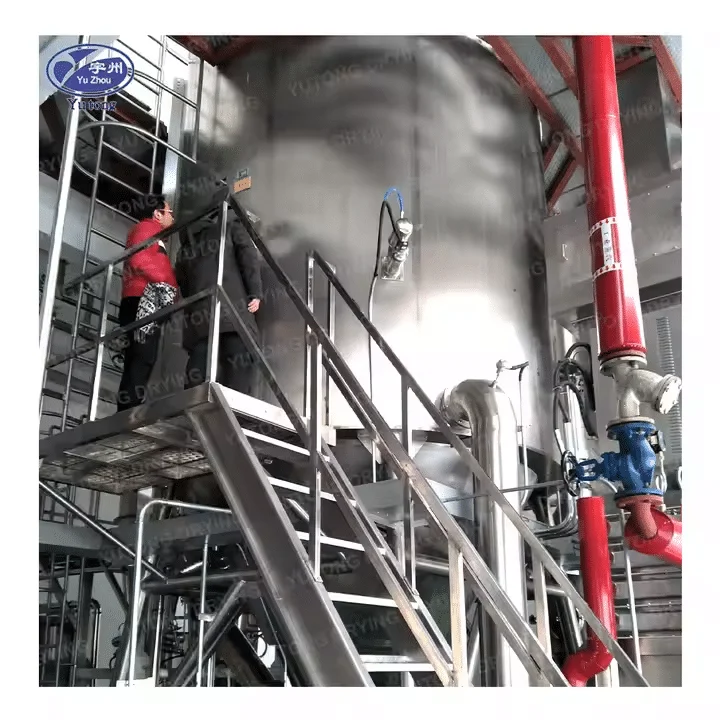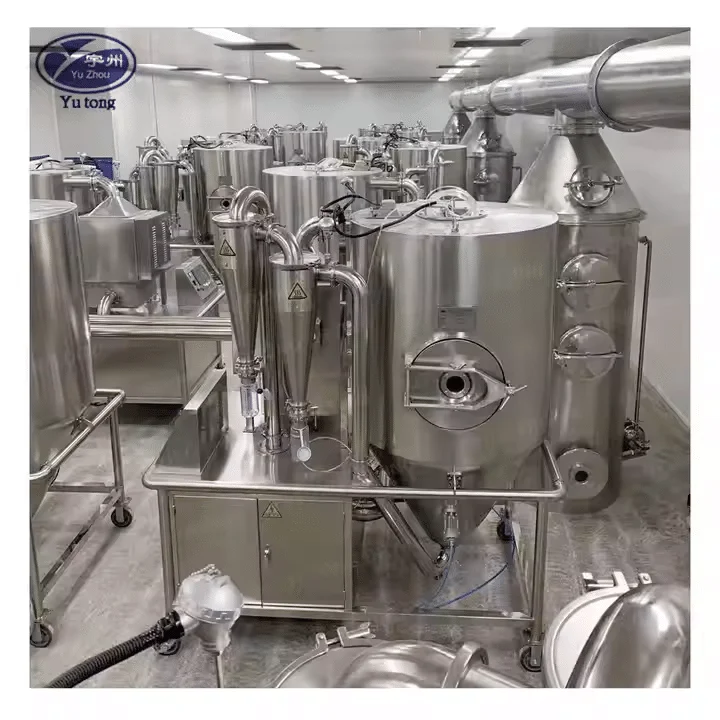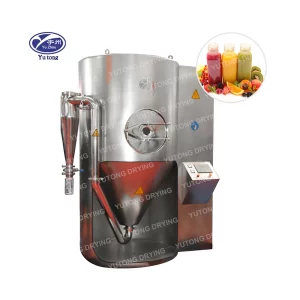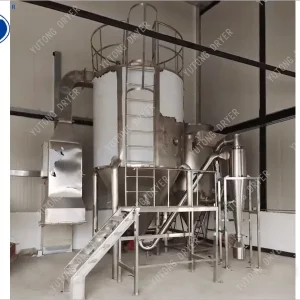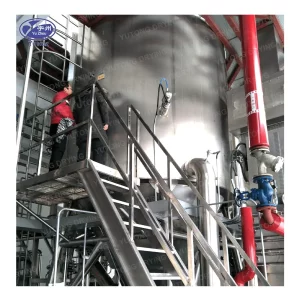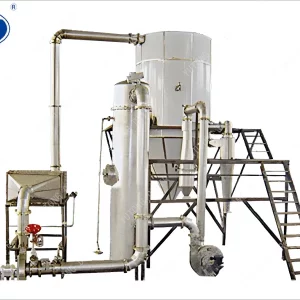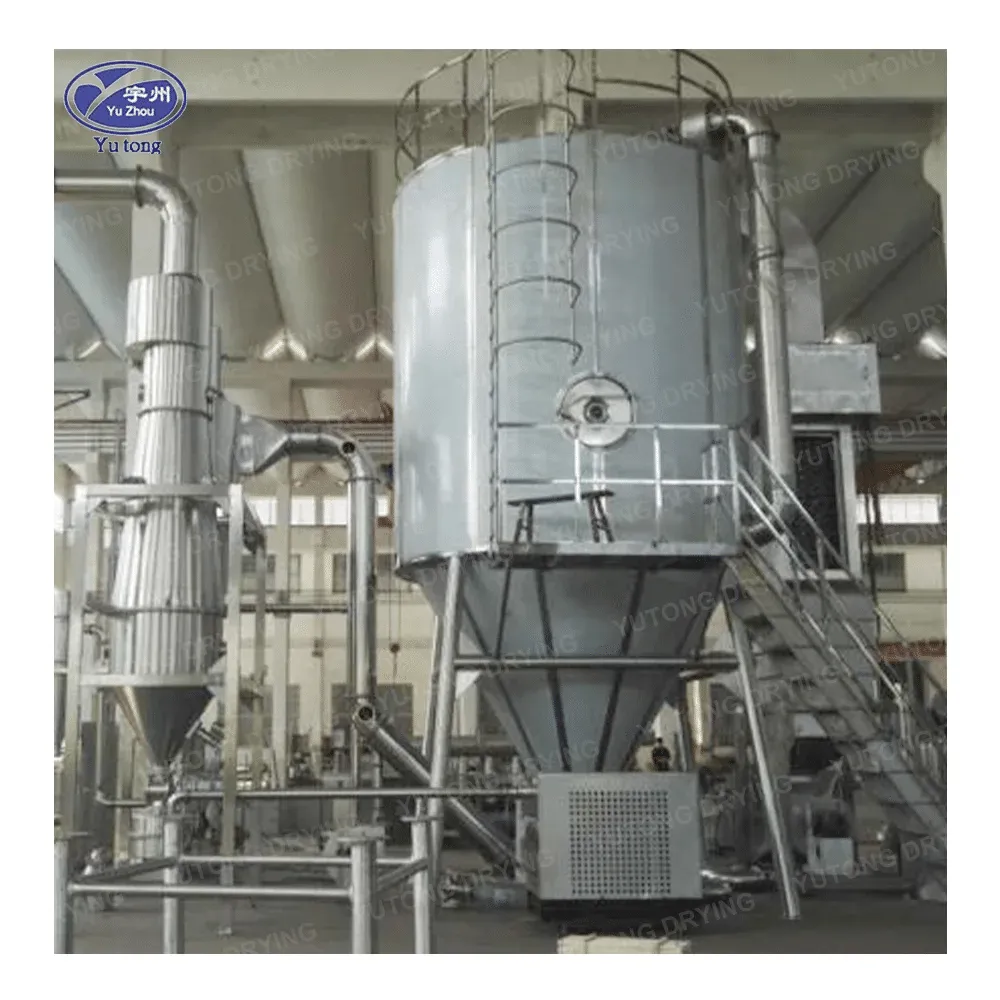Le séchage par atomisation est une méthode largement utilisée dans diverses industries, telles que l'agroalimentaire, la pharmacie et la chimie, pour transformer des solutions liquides ou des boues en poudres sèches. Le calcul de la capacité d'un sécheur par atomisation est essentiel pour garantir une production efficace et des performances optimales. Dans ce guide, nous explorerons les concepts de base de la conception d'un sécheur par atomisation, les paramètres clés et les étapes pratiques pour calculer sa capacité.
Comprendre les bases du séchoir par pulvérisation
Un sécheur par atomisation est un appareil qui transforme un liquide en poudre en le pulvérisant dans un milieu de séchage chaud. Il se compose de plusieurs éléments, dont un atomiseur, une chambre de séchage et un système de traitement d'air. Comprendre son principe de fonctionnement et les considérations de conception est essentiel pour calculer sa capacité.
Composants clés d'un séchoir par atomisation
Atomiseur
L'atomiseur est un composant essentiel qui transforme le liquide en fines gouttelettes. Différents types d'atomiseurs, tels que les atomiseurs rotatifs et à buse, peuvent être utilisés en fonction de la granulométrie et des caractéristiques du produit. Le choix de l'atomiseur influence l'uniformité des gouttelettes et l'efficacité du processus de séchage.
Chambre de séchage
La chambre de séchage est l'endroit où les gouttelettes pulvérisées rencontrent l'air chaud, provoquant une évaporation rapide. La conception de la chambre de séchage, notamment sa forme et sa taille, influence l'efficacité du séchage des gouttelettes. Des facteurs tels que le temps de séjour et les flux d'air à l'intérieur de la chambre sont essentiels pour un séchage optimal.
Système de traitement d'air
Le système de traitement de l'air alimente la chambre de séchage en air chaud et évacue l'air chargé d'humidité. Il comprend des composants tels que des ventilateurs, des radiateurs et des filtres qui assurent une température et une propreté optimales de l'air. Une bonne gestion de l'air garantit des conditions de séchage constantes et prévient la contamination du produit final.
Paramètres typiques dans la conception d'un sécheur par atomisation
Pour calculer efficacement la capacité du sécheur par atomisation, vous devez prendre en compte plusieurs paramètres de conception :
Températures d'entrée et de sortie
La température de l'air entrant et sortant de la chambre de séchage est cruciale pour déterminer l'efficacité. Des températures d'entrée élevées peuvent accélérer le séchage, mais peuvent également affecter la qualité du produit. La température de sortie doit être surveillée attentivement pour garantir un séchage complet sans surchauffe du produit.
Débit d'air
Le volume d'air circulant dans le séchoir influence le temps et la capacité de séchage. Un débit d'air plus élevé peut améliorer l'efficacité du séchage, mais peut nécessiter davantage d'énergie. L'équilibre entre le débit d'air et d'autres paramètres est essentiel pour optimiser le processus de séchage.
Taux d'alimentation
La quantité de liquide entrant dans le système est un facteur déterminant de la capacité. Le débit d'alimentation doit être ajusté en fonction de la teneur en humidité et du temps de séchage souhaité. Un débit d'alimentation constant garantit une qualité de produit uniforme et évite la surcharge du système de séchage.
Taille des particules
La granulométrie souhaitée du produit final influence le choix de l'atomiseur. Les particules plus petites sèchent plus rapidement, mais peuvent nécessiter un contrôle plus précis des conditions de séchage. La granulométrie cible doit correspondre à l'application prévue de la poudre.
Étapes pour calculer la capacité du sécheur par atomisation
Le calcul de la capacité d'un séchoir par atomisation implique plusieurs calculs, notamment l'efficacité thermique, le bilan matière et le dimensionnement. Voici une approche étape par étape :
Étape 1 : Calculer l'efficacité thermique
L'efficacité thermique mesure l'efficacité avec laquelle le sèche-linge convertit l'énergie en capacité de séchage. Elle est calculée selon la formule suivante :
Comprendre l'efficacité thermique
L'efficacité thermique reflète la proportion d'énergie utilisée pour le séchage par rapport à l'énergie perdue sous forme de chaleur. Un rendement thermique élevé indique que le séchoir utilise efficacement l'énergie, ce qui entraîne une réduction des coûts d'exploitation et de l'impact environnemental.
Application de la formule
[ \text{Efficacité thermique} = \left( \frac{\text{Température de l'air de sortie} – \text{Température de l'air d'entrée}}{\text{Température de l'air d'entrée} – \text{Température de l'air ambiant}} \right) \times 100 ]
Cette formule permet d'évaluer les performances du sécheur dans diverses conditions de fonctionnement. Un calcul régulier de l'efficacité thermique permet d'identifier les points à améliorer.
Améliorer l'efficacité thermique
Les stratégies visant à améliorer l'efficacité thermique comprennent l'optimisation de la température d'entrée d'air et une isolation adéquate de la chambre de séchage. Un entretien régulier du système de traitement d'air permet également de prévenir les pertes d'énergie et d'améliorer l'efficacité globale.
Étape 2 : Déterminer la taille du sécheur par pulvérisation
La taille d'un séchoir par atomisation est déterminée par le volume d'air et le temps de séchage requis. Utilisez la formule suivante pour calculer le débit d'air requis :
Facteurs influençant le dimensionnement
Le dimensionnement du sécheur par atomisation dépend de facteurs tels que le débit d'alimentation, la teneur en humidité souhaitée du produit et le temps de séchage. Un dimensionnement précis du sécheur garantit sa capacité à répondre aux exigences de production sans goulots d'étranglement.
Formule de dimensionnement
[ \text{Débit d'air (m}^3/\text{h)} = \frac{\text{Débit d'alimentation (kg/h)}}{\text{Teneur en humidité} \times \text{Temps de séchage (h)}} ]
Cette formule fournit une base de référence pour déterminer le débit d'air nécessaire pour obtenir les résultats de séchage souhaités. Des ajustements peuvent être nécessaires en fonction des exigences de production spécifiques.
Équilibrer la taille et l'efficacité
Bien qu'un séchoir plus grand puisse traiter davantage de fourrage, il peut entraîner une consommation d'énergie plus élevée. Trouver le juste équilibre entre taille et efficacité est crucial pour garantir un fonctionnement optimal du séchoir, sans dépense énergétique inutile.
Étape 3 : Calculer la capacité du sécheur par pulvérisation
Pour calculer la capacité, il faut considérer le bilan massique du système. L'équation de base est :
Considérations sur le bilan massique
Comprendre le bilan massique implique de suivre les entrées et les sorties de matières dans le séchoir. Cela inclut la prise en compte de l'élimination de l'humidité et des pertes potentielles pendant le processus de séchage.
Calcul de capacité
[ \text{Capacité (kg/h)} = \text{Débit d'alimentation} – \left( \text{Débit d'air} \fois \text{Teneur en humidité} \right) ]
Ce calcul permet de déterminer la quantité maximale de produit sec pouvant être produite par heure. Une mise à jour régulière de ce calcul garantit que le séchoir atteint ses objectifs de production.
Ajustement aux conditions variables
Des facteurs tels que des modifications de la composition de l'alimentation ou des conditions ambiantes peuvent nécessiter un réétalonnage des calculs de capacité. La flexibilité d'ajustement de ces calculs garantit l'efficacité du séchoir dans des conditions variables.
Étape 4 : Optimiser l’efficacité
Pour augmenter l’efficacité d’un séchoir par atomisation, envisagez les stratégies suivantes :
Optimiser la température d'entrée
Des températures d'entrée plus élevées peuvent améliorer l'efficacité du séchage, mais doivent être équilibrées avec la qualité du produit. Un contrôle rigoureux de la température peut prévenir la dégradation du produit et garantir une qualité constante.
Améliorer la distribution de l'air
Une circulation d'air régulière dans la chambre de séchage assure un séchage uniforme. Une conception optimisée des systèmes de distribution d'air permet d'éviter les points chauds et les séchages irréguliers, pour un produit final plus homogène.
Améliorer l'atomisation
Des gouttelettes plus fines permettent un séchage plus efficace. Choisir le bon atomiseur et l'entretenir correctement peut améliorer l'uniformité des gouttelettes et optimiser les performances globales de séchage.
Exemple pratique : conception d'un séchoir par atomisation pour le lait en poudre
Appliquons ces calculs à un exemple pratique dans l’industrie alimentaire : la conception d’un séchoir par atomisation pour le lait en poudre.
Considérations de conception pour le lait en poudre
Température typique
La température d'entrée est généralement d'environ 180 °C et la température de sortie d'environ 90 °C. Ces températures assurent un séchage rapide tout en préservant les qualités nutritionnelles et organoleptiques du lait en poudre.
Caractéristiques de l'alimentation
Le lait présente une teneur en humidité élevée qui nécessite un séchage efficace. Le débit d'alimentation et l'atomisation doivent être soigneusement contrôlés pour obtenir le taux d'humidité souhaité dans le produit final.
Taille des particules
Une granulométrie uniforme est essentielle à la solubilité et à la texture. Le choix de l'atomiseur et des conditions de séchage doit être optimisé pour obtenir un produit homogène et de haute qualité.
Étapes de calcul
Déterminer le débit d'air
En fonction de la granulométrie et du taux d'humidité souhaités, calculez le débit d'air nécessaire pour un séchage efficace. Des ajustements peuvent être nécessaires pour équilibrer la vitesse de production et la consommation d'énergie.
Calculer l'efficacité thermique
À l'aide des températures d'entrée et de sortie, évaluez l'efficacité thermique du sécheur. Un suivi régulier peut mettre en évidence les possibilités d'amélioration de la consommation énergétique.
Estimer la capacité
À l'aide de la méthode du bilan massique, estimez la capacité du séchoir par atomisation. Cela permet de planifier les calendriers de production et de garantir que le séchoir répond à la demande.
Conclusion
Le calcul de la capacité d'un séchoir par atomisation est un processus en plusieurs étapes qui implique la compréhension des principes fondamentaux du séchage par atomisation, l'évaluation des paramètres de conception clés et la réalisation de calculs spécifiques. En suivant ces étapes et en optimisant l'efficacité, vous garantirez le bon fonctionnement de votre séchoir par atomisation et satisferez aux exigences de production.
Que vous conceviez un nouveau sécheur par atomisation ou optimisiez un système existant, ces conseils vous aideront à atteindre la capacité et l'efficacité souhaitées. Une évaluation régulière et une adaptation aux conditions changeantes peuvent améliorer encore les performances.
N'oubliez pas que les calculs et stratégies présentés dans ce guide peuvent être appliqués à diverses applications de séchage par atomisation, de la production alimentaire à la transformation chimique. Avec la bonne approche, vous pouvez optimiser les performances de vos opérations de séchage par atomisation, garantissant ainsi une qualité de produit constante et une efficacité opérationnelle optimale.

